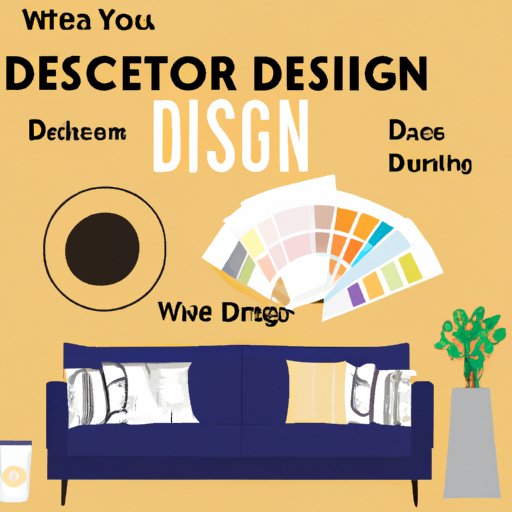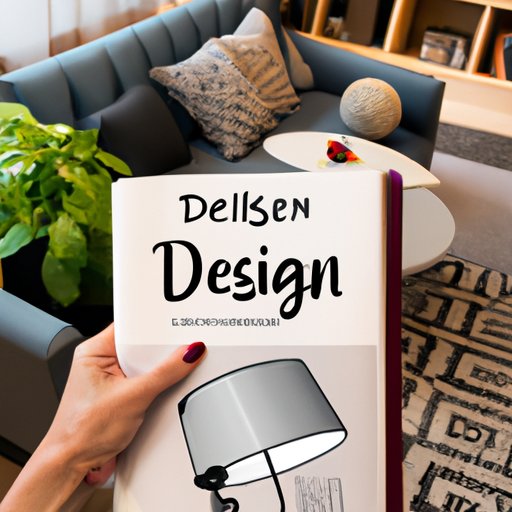Introduction
Interior designers create aesthetically pleasing and functional spaces within homes, offices, and other buildings. They are responsible for designing, planning, and furnishing interiors that meet both their clients’ needs and desires. This article will explore the role of an interior designer, including what they do, the education and training required to become one, a typical day in the life of an interior designer, and tips for finding the right person for the job.
Exploring the Role of an Interior Designer
An interior designer is someone who plans and oversees the design of residential or commercial interiors. They use their expertise in color, texture, lighting, and furniture placement to create attractive and inviting spaces. Interior designers often work with architects and contractors to ensure that the design meets all safety and building codes. In addition, they help their clients choose materials, fabrics, and finishes that fit their budget and lifestyle.
What Does an Interior Designer Do?
Interior designers typically start by meeting with their clients to discuss their needs, goals, and preferences. They then develop a design plan based on the client’s specifications. This may include selecting paint colors, flooring, lighting fixtures, furniture, and accessories. They may also be responsible for ordering and overseeing the installation of these items. Additionally, they may need to coordinate with contractors to ensure that all aspects of the project are completed according to the design plan.
Specialized Areas of Interior Design
Interior designers typically specialize in one or more areas of design, such as residential, commercial, healthcare, hospitality, or retail. Depending on their specialty, they may work on projects such as remodeling a kitchen or designing a hotel lobby. Some interior designers focus solely on decorating, while others may take on larger projects such as space planning and layout.
Education and Training Requirements
Most interior designers have a bachelor’s degree in interior design, architecture, or a related field. Many employers also require experience in the field, either through internships or other hands-on training. Additionally, most states require interior designers to be licensed or certified. To obtain a license or certification, designers must pass the National Council for Interior Design Qualification (NCIDQ) exam.

The Ins and Outs of Becoming an Interior Designer
Licensing and Certification
In order to practice as an interior designer, most states require licensure or certification. The NCIDQ exam covers topics such as building codes, accessibility standards, and interior design principles. To be eligible to take the exam, applicants must have at least six years of combined education and experience in interior design. Additionally, some states have additional licensing requirements, such as completion of a specific number of hours of continuing education courses.
Professional Associations
Interior designers can join professional associations, such as the American Society of Interior Designers (ASID). Membership in such organizations provides access to resources, networking opportunities, and continuing education credits. Additionally, some associations offer certifications in specialized areas of interior design, such as sustainable design, healthcare design, and hospitality design.
Types of Clients Served
Interior designers may work with a variety of clients, from individual homeowners to large corporations. Some specialize in residential design, while others may focus on commercial or corporate clients. Some designers may even work with government agencies or non-profit organizations.
A Day in the Life of an Interior Designer
Typical Tasks and Responsibilities
A day in the life of an interior designer may vary depending on the type of project they’re working on. For example, a designer working on a residential project might spend the day meeting with clients to discuss their vision, researching materials and suppliers, creating sketches and renderings, and ordering furniture and accessories. On the other hand, a designer working on a commercial project might spend their day attending meetings with architects and contractors, ensuring that the design meets building codes and regulations, and coordinating installation of the design elements.
Working with Clients
Interior designers often spend much of their day working with clients. This includes discussing their vision, developing a design plan, and providing advice on materials, finishes, and furniture. It’s important for designers to be able to listen carefully to their clients’ needs and provide creative solutions that meet those needs.
Interacting with Contractors and Vendors
Interior designers often work closely with contractors and vendors to ensure that their designs are implemented correctly. This may involve scheduling meetings with contractors to discuss details of the project, ordering materials and supplies, and overseeing installation. Additionally, designers may need to negotiate prices with vendors to ensure that their clients stay within their budget.

Interviewing a Professional Interior Designer
Questions to Ask
When interviewing potential interior designers, it’s important to ask questions about their experience, portfolio, and approach to design. Specifically, inquire about their experience with similar projects, how they would handle any challenges that arise during the project, and what their process looks like from start to finish. Additionally, ask for references from previous clients and make sure to follow up with them.
Tips for Finding the Right Person
It’s important to find an interior designer who is the right fit for your project. When searching for candidates, look for someone who has experience in the type of project you’re looking to complete. Additionally, make sure to research their portfolio and read reviews from previous clients. Lastly, don’t be afraid to ask questions and get to know the designer before making a decision.
Trends in Interior Design
Latest Styles and Techniques
Interior design is constantly evolving and new styles and techniques are emerging every year. Popular trends in 2021 include the use of bright colors and bold patterns, natural textures, and layered lighting. Additionally, many designers are incorporating sustainable materials and energy-efficient technologies into their designs.
Sustainable and Eco-Friendly Materials
Many interior designers are turning to sustainable and eco-friendly materials in their designs. This includes using reclaimed wood, recycled glass, and low-VOC paints and finishes. Additionally, designers are incorporating energy-efficient lighting, water-saving plumbing fixtures, and green building practices into their designs.

How to Hire an Interior Designer
Factors to Consider
When hiring an interior designer, there are several factors to consider. First, determine your budget and timeline for the project. Next, decide on the type of design you’re looking for and research designers who specialize in that area. Be sure to ask for references and read reviews from past clients. Lastly, make sure to interview several designers to find the right fit for your project.
Questions to Ask
When interviewing potential interior designers, it’s important to ask questions about their experience, portfolio, and approach to design. Specifically, inquire about their experience with similar projects, how they would handle any challenges that arise during the project, and what their process looks like from start to finish. Additionally, ask for references from previous clients and make sure to follow up with them.
Tips for Finding the Right Professional
Finding the right interior designer for your project is essential. Look for someone who has experience in the type of project you’re looking to complete. Additionally, make sure to research their portfolio and read reviews from previous clients. Lastly, don’t be afraid to ask questions and get to know the designer before making a decision.
Conclusion
Interior designers are responsible for creating aesthetically pleasing and functional spaces within homes, offices, and other buildings. This article explored the role of an interior designer, including what they do, the education and training required to become one, a typical day in the life of an interior designer, and tips for finding the right person for the job. From discussing their vision with clients to coordinating with contractors, interior designers play an important role in bringing people’s design dreams to life.
(Note: Is this article not meeting your expectations? Do you have knowledge or insights to share? Unlock new opportunities and expand your reach by joining our authors team. Click Registration to join us and share your expertise with our readers.)
